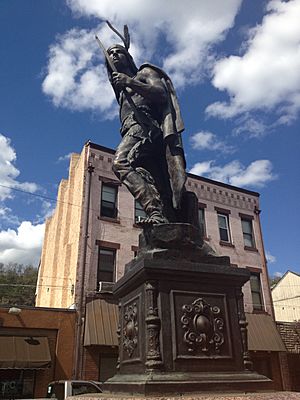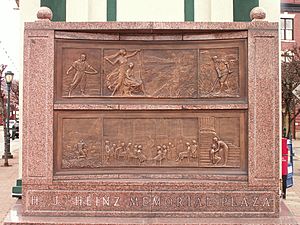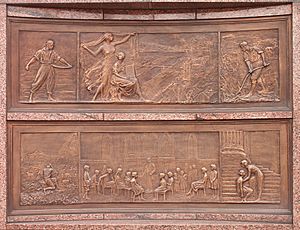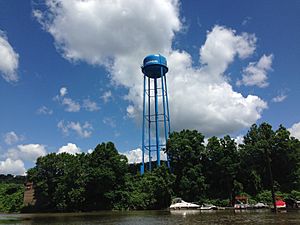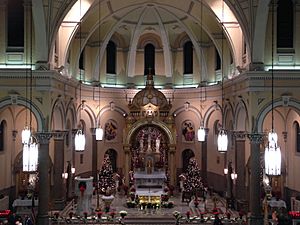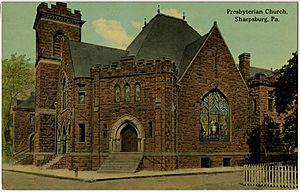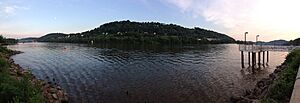Sharpsburg, Pennsylvania facts for kids
Quick facts for kids
Sharpsburg, Pennsylvania
|
|
|---|---|
|
Borough
|
|
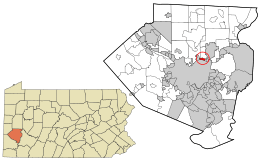
Location in Allegheny County and the U.S. state of Pennsylvania.
|
|
| Country | United States |
| State | Pennsylvania |
| County | Allegheny |
| Established | 1826 |
| Chartered | 1842 |
| Government | |
| • Type | Borough |
| Area | |
| • Total | 0.63 sq mi (1.63 km2) |
| • Land | 0.48 sq mi (1.24 km2) |
| • Water | 0.15 sq mi (0.39 km2) |
| Population
(2020)
|
|
| • Total | 3,187 |
| • Estimate
(2019)
|
3,318 |
| • Density | 6,926.93/sq mi (2,676.96/km2) |
| Time zone | UTC−5 (Eastern (EST)) |
| • Summer (DST) | UTC−4 (EDT) |
| ZIP Code |
15215
|
| Area code(s) | 412, 878 |
| FIPS code | 42-69776 |
Sharpsburg is a small town, called a borough, in Allegheny County, Pennsylvania. It is about 5 miles northeast of downtown Pittsburgh, right along the Allegheny River. In 1900, nearly 7,000 people lived here. The population grew to over 8,900 people by 1920. In 2020, about 3,187 people called Sharpsburg home.
In the past, Sharpsburg was a busy industrial town. It had factories that made things like iron, bricks, and glass. It also had machine shops and companies that produced varnish, lumber products, and wire. In 1869, the famous H. J. Heinz Company started in Sharpsburg. It was first known as Heinz Noble & Company and made bricks.
Contents
Sharpsburg's Location and Surroundings
Sharpsburg is located at coordinates 40.495368 degrees North and -79.928991 degrees West.
The United States Census Bureau says the borough covers about 0.6 square miles. Most of this area, about 0.5 square miles, is land. The rest, about 0.2 square miles, is water.
Neighboring Areas of Sharpsburg
Sharpsburg shares its land borders with five other places. To the west is Etna. To the northwest is Shaler Township. Parts of O'Hara Township are to the north and southeast. To the east is Aspinwall.
South of Sharpsburg, across the Allegheny River, are two neighborhoods of Pittsburgh. You can reach them by crossing the 62nd Street Bridge. These neighborhoods are Upper Lawrenceville and Morningside.
People Living in Sharpsburg
Sharpsburg has seen its population change over the years. Here's how many people have lived there at different times:
| Historical population | |||
|---|---|---|---|
| Census | Pop. | %± | |
| 1850 | 1,229 | — | |
| 1860 | 1,436 | 16.8% | |
| 1870 | 2,176 | 51.5% | |
| 1880 | 3,466 | 59.3% | |
| 1890 | 4,898 | 41.3% | |
| 1900 | 6,842 | 39.7% | |
| 1910 | 8,153 | 19.2% | |
| 1920 | 8,921 | 9.4% | |
| 1930 | 8,642 | −3.1% | |
| 1940 | 8,202 | −5.1% | |
| 1950 | 7,296 | −11.0% | |
| 1960 | 6,096 | −16.4% | |
| 1970 | 5,453 | −10.5% | |
| 1980 | 4,351 | −20.2% | |
| 1990 | 3,781 | −13.1% | |
| 2000 | 3,594 | −4.9% | |
| 2010 | 3,446 | −4.1% | |
| 2020 | 3,187 | −7.5% | |
| 2019 (est.) | 3,318 | −3.7% | |
| Sources: | |||
In 2000, there were 3,594 people living in Sharpsburg. Most residents were White (93.74%). About 3.81% were African American, and smaller groups were Asian or from other backgrounds. About 2.11% of the population was Hispanic or Latino.
The average age in Sharpsburg in 2000 was 42 years old. About 20.1% of the people were under 18. About 22.3% were 65 years or older.
Education in Sharpsburg
Students in Sharpsburg attend schools in the Fox Chapel Area School District.
- High school students go to Fox Chapel Area High School.
- Middle school students attend Dorseyville Middle School.
- Elementary school students go to Kerr Elementary School.
In 2017, the Fox Chapel Area School District was ranked as the second-best school district in the Pittsburgh area. It was also ranked sixth in the entire state of Pennsylvania.
Sharpsburg's History
Sharpsburg has a long and interesting history, going back to the 1700s.
Guyasuta and the Seneca People
The area where Sharpsburg is located was once home to the Seneca people. A very important Seneca warrior and hunter named Guyasuta lived here. He even guided George Washington on a trip in 1753. Years later, when they met again, Washington greeted Guyasuta warmly.
Guyasuta worked for peace with the British Army in the early 1760s. His efforts led to a peace treaty. Through this treaty, the government received land in what is now western Pennsylvania. General James O'Hara bought some of this land along the river. He then gave a small part of it, where Sharpsburg is today, to Guyasuta.
James Sharp and the First Settlement
In 1826, a man named James Sharp bought over 257 acres of land in this area. He paid $1,337.37 for it. He built a log cabin for his wife, Isabella L. Sharp. The official record of this purchase is from October 10, 1826.
James Sharp opened his land for other settlers. He built a school and a church. He kept donating land as the community grew. On March 14, 1842, Sharpsburg officially became a borough.
James Sharp was born in Pennsylvania in 1784. His family was from Scotland. His grandfather, Captain James Sharp, fought in the Forbes Campaign in 1758. His father, Matthew Sharp, fought in the Revolutionary War.
James Sharp moved to Pittsburgh in 1797. In 1826, he bought the land that would become Sharpsburg. This land had a log house, an orchard, and good meadows. It also had a coal mine and a great spring. James Sharp was known as a kind and generous person. He believed in ending slavery, supporting education for everyone, and the temperance movement (which encouraged people to drink less alcohol). He passed away on March 12, 1861.
Sharpsburg's Industrial Past
After it became a borough, Sharpsburg grew into an industrial town. Factories made iron, bricks, and glass. Goods were moved through a canal that ran through the town and on the Allegheny River. When railroads became popular, Sharpsburg continued to do well. Thousands of people came for the many job opportunities.
The H. J. Heinz Company Begins Here
One of the most famous companies that started in Sharpsburg is the H. J. Heinz Company. The Heinz glass factory in Sharpsburg used to make all the glass bottles and jars for Heinz products. In 1869, Henry J. Heinz started making and bottling his first horseradish in his kitchen in Sharpsburg. This house became Heinz's first factory.
Even after he moved his company to Pittsburgh, Henry J. Heinz was very generous to the people of Sharpsburg. He gave gifts to the community that had been his family home for many years. One of these gifts was a life-sized statue of Guyasuta. This statue was placed where Main and North Canal streets meet. The statue has been damaged twice by cars, once in 1930 and again in 1988. Each time, a new statue was made to replace it.
A Town Once Divided
Less than a hundred years ago, Sharpsburg was split into two parts. A railroad track ran through the area where Kennedy Park is now. Because of this, there were two fire departments, one on each side of the tracks. There were also two schools, one "up street" and one "down street."
When the railroad tracks were no longer used, the train cars sat empty. The Junior Chamber of Commerce in Sharpsburg worked with the railroad company and the Heinz family to change this. The Heinz family offered to help build a park if it was only used for fun activities. The park was built around the time President John F. Kennedy was assassinated, which is why it was named Kennedy Park.
Today, Sharpsburg is proud of its industrial past. It is also looking forward to new chances for economic growth in its business area. Residents enjoy being part of this special riverfront community.
Public Services
Sharpsburg has several important public services for its residents.
Water Supply
The Hampton Shaler Water Authority (HSWA) provides water to Sharpsburg. HSWA serves over 23,600 customers in ten different towns in Allegheny County. HSWA was formed in 2011 by combining two other water departments.
HSWA usually pumps and treats 5 to 6 million gallons of water every day. They have over 314 miles of water pipes, ten water storage tanks, twelve pumping wells, and one water treatment plant.
Wastewater Treatment
The Allegheny County Sanitary Authority (ALCOSAN) collects and treats wastewater from Sharpsburg. ALCOSAN's treatment plant is located along the Ohio River in Pittsburgh. It is one of the largest wastewater treatment facilities in the Ohio River Valley. It can process up to 250 million gallons of wastewater daily.
ALCOSAN is focused on protecting the environment and using new technology. They have completed a $400 million project to improve their facilities. Now, they are working on an even bigger project, costing $1 billion, to manage combined sewer overflows.
Trash Collection
Waste Management is the company that collects trash in Sharpsburg. They pick up trash from the curb every week.
Recycling Services
Waste Management also provides curbside recycling for residents. People can recycle aluminum, glass, metal cans, plastics, mixed paper, and cardboard. Recycling pickup started in Sharpsburg in early 2023.
Places of Worship
Sharpsburg is home to many churches and other religious places. The Catholic community is quite notable in the borough. Three churches, St. Mary Church, Madonna of Jerusalem Church, and St. John Cantius Church, have joined together to form the Saint Juan Diego Parish. This parish was created in 2009 by Bishop David Zubik of the Diocese of Pittsburgh. The name Saint Juan Diego was chosen because of Sharpsburg's connection to Native Americans, like Guyasuta and the Senecas. Saint Juan Diego was a Native American from Mexico.
Other churches in Sharpsburg include Grace Methodist Church, Mt. Olive Baptist Church, First English Lutheran Church, First Evangelical Lutheran Church, and the Sharpsburg Family Worship Center.
Sharpsburg Community Library
In the summer of 2015, the Sharpsburg Community Library reopened after a big renovation. The project cost one million dollars, funded by state grants and private donations. The library became larger and had a new design. It also added more books and materials for people to borrow. Residents, the Sharpsburg council, and various charities helped organize the reopening. The library's design won an award in 2015 from the American Institute of Architects Pittsburgh chapter.
The library also has the Sharpsburg Community Garden. This garden has many raised beds where residents can grow their own vegetables.
Recreation and Parks
Sharpsburg has five parks where people can relax and have fun:
- James Sharp Landing
- Heinz Memorial Field
- Kennedy Park
- Kenneth D. Curley Memorial Park
- Children's Park (at 16th and Main Streets)
Heinz Memorial Field has a hockey rink, two basketball courts, and a baseball field. There are also many play sets for children.
Kennedy Park is in the middle of the borough. It's a large open space used for the annual Guyasuta Days Festival in August. Kennedy Park has outdoor facilities, including a kitchen area and seating. It also has a large basketball court.
Children's Park is open in the spring and summer. It has a water fountain that children use to cool off on hot summer days. The park also has swings, carousels, a teeter-totter, a basketball court, and a picnic area.
James Sharp Landing
Sharpsburg also has a free boat launch called James Sharp Landing. It is located at 13th and Main Streets. It's a great place to enjoy the outdoors in spring, summer, and fall. The Landing was built with help from the borough council and government support. It attracts many people who want to enjoy the river.
The Landing has a boat launch, a 30-foot fishing pier, a pavilion, a gazebo, and a kayak launch. It also hosts the annual Sharpsburg Fishing Derby. Hundreds of people come to try and win the grand prize, which has been as high as $40,000 in recent years.
The Linden Gymnasium / Sharpsburg Recreation Center
The Linden Gymnasium, also known as the Sharpsburg Recreation Center, was built in the late 1880s or early 1890s. It was first used as a gymnasium for the Young Men's Christian Association (YMCA). Later, the Sharpsburg School District bought it for Sharpsburg High School. In 1970, the Sharpsburg School District joined with the Fox Chapel Area School District.
In 1982, the Fox Chapel Area School District sold the building to the borough. Now, the Sharpsburg Recreation Committee manages it. The Linden Gym is home to local club teams, the Sharpsburg Wolves and Junior Wolves. It also hosts the annual John "Tip" Veltri Basketball Tournament.
Famous People from Sharpsburg
- Guyasuta: A famous Chief of the Seneca Indians.
- Henry J. Heinz: The founder of the H. J. Heinz Company.
- Lawrence Saint: A talented artist who created stained glass.
- Don Celender: An American conceptual artist and professor.
- Robert D. Fleming: A Pennsylvania State Senator.
- Jim Miller: An American football player.
See also
 In Spanish: Sharpsburg (Pensilvania) para niños
In Spanish: Sharpsburg (Pensilvania) para niños


